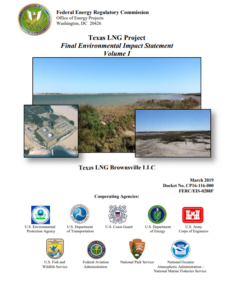The staff of the Federal Energy Regulatory Commission (FERC) has prepared a final environmental impact statement (FEIS) for the Texas LNG Project proposed by Texas LNG Brownsville, LLC (Texas LNG).
Texas LNG requests authorization under Section 3(a) of the Natural Gas Act and Part 153 of the Commission’s regulations to site, construct, and operate an LNG terminal to liquefy and export natural gas at a proposed site on the Brownsville Ship Channel in Cameron County, Texas.
Natural gas would be delivered to the Texas LNG Project site via a non-jurisdictional intrastate, 30-inch-diameter natural gas pipeline that would be constructed, owned, and operated by a third party, separate from Texas LNG.
The FEIS has been prepared in compliance with the requirements of the National Environmental Policy Act (NEPA), the Council on Environmental Quality regulations for implementing NEPA in Title 40 Code of Federal Regulations, Parts 1500–1508 (40 CFR 1500-1508), and FERC regulations implementing NEPA (18 CFR 380).
We determined that the construction and operation of the Texas LNG Project would result in adverse environmental impacts. However, the impacts on the environment from the proposed Project would be reduced to less than significant levels with the implementation of Texas LNG’s proposed impact avoidance, minimization, and mitigation measures and the additional measures recommended by FERC staff, with the exception of visual resources.
In addition, the Texas LNG Project, combined with other projects in the geographic scope, including the Rio Grande LNG and Annova LNG Projects, would result in significant cumulative impacts from sediment/turbidity and shoreline erosions within the Brownsville Ship Channel during operations from vessel transits, the Commission said.
The conclusions were based upon information provided by Texas LNG and through data requests; field investigations; literature research; geospatial analysis; alternatives analysis; public comments and scoping sessions; and coordination with federal, state, and local agencies and Native American tribes.
The following factors were also considered in the conclusions:
- The LNG terminal would be constructed in an area currently zoned for commercial and industrial use, along an existing, man-made ship channel.
- Texas LNG would follow its Spill Prevention and Response Plan (construction), Spill Prevention Control and Countermeasures Plan (operation), Stormwater Pollution Prevention Plan, Noxious Weed and Invasive Plant Plan, Facility Lighting Plan, Migratory Bird Plan, Terrestrial Reptile and Amphibian Conservation Plan, Unanticipated Discovery Plan for cultural resources, and Fugitive Dust Control Plan.
- The USCG issued a Letter of Recommendation indicating that the Brownsville Ship Channel would be considered suitable for the LNG marine traffic associated with the Project.
- The US Department of Transportation has no objection to Texas LNG’s methodology to comply with the 49 CFR 193 siting requirements for the LNG terminal.
- All appropriate consultations with the FWS and NMFS regarding federally listed threatened and endangered species would be completed before construction is allowed to start.
- All appropriate National Historic Preservation Act consultations with the Texas State Historic Preservation Office and Advisory Council on Historic Preservation would be completed before construction is allowed to start in any given area.
- Texas LNG would implement its Project-specific Environmental Construction Plan, which incorporates our Upland Erosion Control, Revegetation, and Maintenance Plan and Wetland and Waterbody Construction and Mitigation Procedures, to minimize impacts on soils, wetlands, and waterbodies.
- The FERC’s environmental and engineering inspection and mitigation monitoring program for this Project would ensure compliance with all mitigation measures and conditions of any FERC authorization.
The FERC Commissioners will take into consideration staff’s recommendations when they make a decision on the Project.
Explore more herebelow:
































































